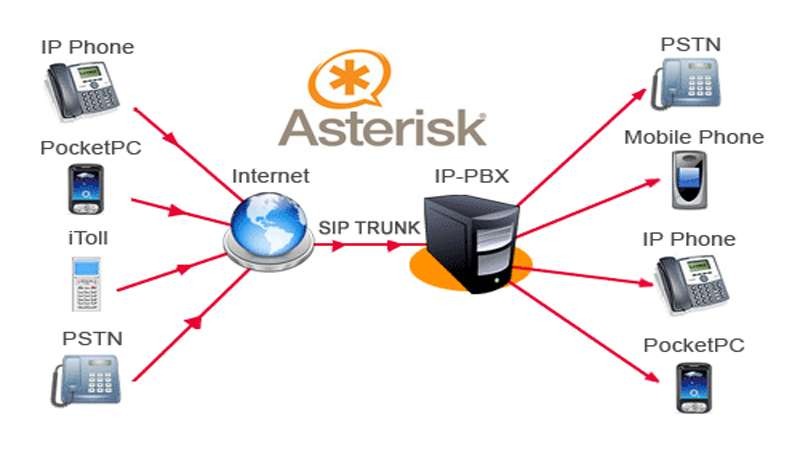This is an entry-level course. There are no prerequisites to attend this training.
IP Telephony with ASTERISK

This course will teach participants how to install, configure and maintain the popular Asterisk IP PBX. Asterisk is software that turns an ordinary computer into a PBX, VoIP Gateway, and conference server all rolled into one. At the end of the course, participants are expected to have an in-depth knowledge of Asterisk and its possible, applications in the world of digital telephony. In order for the course to be beneficial, the trainees must have installed and played with Linux in the past and must be comfortable with the Linux CLI and basic text editing tools. This course also designed on VoIP, VSP, IGW, ICX, IIG ISP, IPTSP, Mobile & Telecom Company based VoIP infrastructure to prepare you for a successful VoIP professional.
Course Objectives
After completing this course, students will be able to
- Advance knowledge of VoIP
- Analogue and digital circuits, PBXs, trunk and tie lines
- Different types of voice Codec
- Signaling protocols H323, MGCP, SIP, SCCP and protocols, RTP and RTCP
- Dial peers and plans, voice gateways
- IPTSP provider circuits
- Messaging and call processing
- Understanding of Infrastructure and equipment required for voice and data at layer 2
- Install and configure Asterisk IP PBX System
- Billing System, Configuring dial plans.
Target Audience
- IT Professional
- Network Professional
- Network Admin
- System Engineer
Course Pre-Requisites
Course Summary
Course Fee
৳ 15,000
Training Method
Offline/Online
Total Modules
12
Course Duration
40 Hours
Total Session
16
Class Duration
2.5 Hours

Details Course Outlines
Module-01
VoIP Overview and IP Network Basics
- Fundamentals of IP Telephony and VoIP
- Analog Telephony and IP Telephony
- Opensource Telecomm Technologies and Softwares
- IP, TCP, UDP, RTP, Mac Address, DNS, Routing, NAT, VPN
- Linux and Open Source Tools and Technologies
Module-02
Telephony and Signaling Systems
- Circuit Switching
- Packet Switching
- Jitter, Delay, Packet Loss
- Time Division Multiplexing
- Transports: E1/T1, STM, SDH, PDH, ISDN, PRI, BRI
- SS7 Signaling
- IP Telephony Protocols: H323, SIP, IAX2
Module-03
Asterisk System and Operations
- Asterisk Architecture
- Hardwares
- Asterisk Modules and Configuration Files
- Audio/Video Codecs and Issues
- DAHDI Drivers
- Asterisk Installation
- Creating Extensions
- Creating Basic Dial plans
Module-04
Switching and Dial Plan
- Contexts
- Extensions
- Priorities
- Applications
- Building an Interactive Dial Plan
- Variables
- Pattern Matching
Module-05
Trunking
- Outside Connectivity
- PSTN Circuits
- *Traditional PSTN Trunks
- *Installing PSTN Trunks
- Coping with NAT
- PSTN Termination
- PSTN Origination
- Configuring VoIP Trunks (SIP/IAX2)
Module-06
Advanced PBX Features and Call Center System
- Parking, Paging and Conferencing
- IVR
- Queues
- ACD
- Agents
Module-07
Number Planning Schemes and ITSP Design and Implementation
- IPTSP Basics and Planning (NSPC,IGW,ICX)
- GOV Regulations and Issues
Module-08
System Monitoring and Logging
- Relational Database Integration
- Call Detail Records (CDR)
- SNMP
- Monitoring Asterisk with OpenNMS
- SIP Message Debugging
- Low Level Debug and Tracing
Module-09
Security and Performance Issues
- QoS and Traffic Prioritization
- Authentication Weakness
- Voice Encryption (SRTP, ZRTP)
- Denial of Service Attacks
- Fail2Ban
- Firewall
Module-10
Web Integration, Monitoring, Reporting and Billing
- FreePBX
- Queue Staus and Reporting
- Flash Operator Pannel
- A2Billing
Module-11
Asterisk based Embedded Solutions, Call Centers and Predictive Dialer Solutions
- GoAutodial
- VICIDial
- Elastix
- Trixbox
- Askozia
Module-12
Asterisk Scalability, Clustering and High Availability Solutions
- SIP Express Router (SER)
- OpenSBC (Session Border Controller)
- Freeswitch
